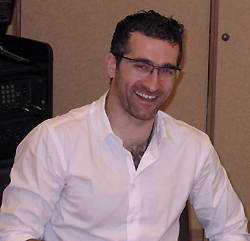Dr. Max Lungarella
The NewScientist.com article Vision-body link tested in robot experiments said
“Experiments involving real and simulated robots suggest that the relationship between physical movement and sensory input could be crucial to developing more intelligent machines.Tests involving two real and one simulated robot show that feedback between sensory input and body movement is crucial to navigating the surrounding world. Understanding this relationship better could help scientists build more life-like machines, say the researchers involved.
Scientists studying artificial intelligence have traditionally separated physical behaviour and sensory input. ‘But the brain’s inputs are not independent,’ says Olaf Sporns, a neuroscientist at Indiana University, US. ‘For example, motor behaviour has a role to play in what the body senses from the environment.’
An increasing number of researchers are taking this approach, known as ‘embodied cognition’, says Sporns. He worked with roboticist Max Lungarella from Tokyo University in Japan, to create experiments that would test the idea.”
Dr. Max Lungarella is currently working at the Laboratory for Intelligent Systems and Informatics of the University of Tokyo in the group of Yasuo Kuniyoshi.
Max is also collaborating with fellow Lifeboat Foundation Scientific Advisory Board member Olaf Sporns from the University of Indiana, the Artificial Intelligence Laboratory of the University of Zurich headed by Rolf Pfeifer, as well as with Hiroshi Yokoi from the University of Tokyo, and Sony’s Intelligence Dynamics Laboratories.
He has a wide range of research interests, which are all directly or indirectly related to understanding better the mechanisms underlying intelligent behavior, and how the application of such knowledge can be mapped onto technological innovation.
Max earned an Electrical Engineering Degree from the University of Perugia, Italy, and a Ph.D. in Artificial Intelligence from the University of Zurich, Switzerland.
He coauthored Methods for quantifying the causal structure of bivariate time series, Morphology, Control, and Passive Dynamics, Mapping causal relations in sensorimotor networks, Exploration of natural dynamics through resonance and chaos, Simulating development in a real robot: on the concurrent increase of sensory, motor, and neural complexity, Robot bouncing: on the interaction between neural and body-environment dynamics, and Information Self-Structuring: Key Principle for Learning and Development. Read his full list of publications!
